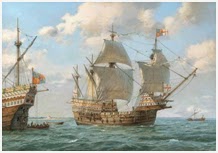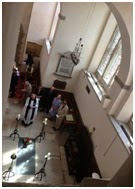Ray Anglesea shares the next installment of his sabbatical experiences
One
of the joys of spending a long weekend with dear friends in Portsmouth was a
visit to see The Mary Rose; one of Henry VIII’s great ships, now housed in the
new Mary Rose Museum located just metres way from Nelson's flagship, HMS
Victory and the ships of the modern Royal Navy.
 Sometime in the late afternoon on July 19th
1545, the Mary Rose heeled to starboard and sank whilst engaging a French
invasion fleet larger than the Spanish Armada 43 years later. Centuries later the
Tudor ship captured the world's imagination when she was raised from the seabed
in 1982; the Flagship is the only sixteenth century warship on display anywhere
in the world. The
excavation and salvage of the Mary Rose was a milestone in the field of
maritime archaeology. The surviving section of the ship and 19,000 thousand
recovered artifacts are of immeasurable value as a Tudor-era time capsule.
Sometime in the late afternoon on July 19th
1545, the Mary Rose heeled to starboard and sank whilst engaging a French
invasion fleet larger than the Spanish Armada 43 years later. Centuries later the
Tudor ship captured the world's imagination when she was raised from the seabed
in 1982; the Flagship is the only sixteenth century warship on display anywhere
in the world. The
excavation and salvage of the Mary Rose was a milestone in the field of
maritime archaeology. The surviving section of the ship and 19,000 thousand
recovered artifacts are of immeasurable value as a Tudor-era time capsule.  As
fascinating as Henry VIII’s naval war machine was the building in which she is
housed in is of considerable architectural interest too. The £27million museum opened in
2012, an elliptical timber-clad building designed by London office Wilkinson
Eyre Architects and built over a late18th Century Dry Dock listed as a
Scheduled Ancient Monument. It was designed with a stained black exterior,
intended to reference traditional English boat sheds of the time, and a
disc-shaped metal roof that curves up over its elliptical body.
As
fascinating as Henry VIII’s naval war machine was the building in which she is
housed in is of considerable architectural interest too. The £27million museum opened in
2012, an elliptical timber-clad building designed by London office Wilkinson
Eyre Architects and built over a late18th Century Dry Dock listed as a
Scheduled Ancient Monument. It was designed with a stained black exterior,
intended to reference traditional English boat sheds of the time, and a
disc-shaped metal roof that curves up over its elliptical body.
The
new boat-shaped Museum showcases the very best of 21st century architecture and
construction, where for the first time visitors can see the starboard section
of the ship's hull with its preserving sprays switched off and the final phase
of the hull's conservation through internal windows in 3 different stories. The
interiors were designed to recreate the dark and claustrophobic atmosphere
found below a ship's deck. Spaces feature low ceilings and are kept
deliberately dark, with lighting directed only onto exhibits and handrails so
that visitors can find their way through the galleries.
 Following
the painstaking archaeological excavation and recording of the exact location
of every find, the project team reunited the original contents - fittings,
weaponry, armament and possessions – deck-by-deck. A virtual hull was constructed
to represent the missing port side with all the guns on their original gun
carriages, cannonballs, gun furniture, stores, chests, rope and rigging.
Visitors to the Museum walk in between the conserved starboard section of the
hull and the virtual hull on three levels, seeing all the main shipboard
material in context as though they are on board the Mary Rose.
Following
the painstaking archaeological excavation and recording of the exact location
of every find, the project team reunited the original contents - fittings,
weaponry, armament and possessions – deck-by-deck. A virtual hull was constructed
to represent the missing port side with all the guns on their original gun
carriages, cannonballs, gun furniture, stores, chests, rope and rigging.
Visitors to the Museum walk in between the conserved starboard section of the
hull and the virtual hull on three levels, seeing all the main shipboard
material in context as though they are on board the Mary Rose.
The
end galleries interpret the context gallery deck-by-deck in more conventional
museum display cases. In them are to be
found the most comprehensive collection of Tudor artefacts in the world from
personal belongings such as wooden bowls, leather shoes, musical instruments
and nit combs complete with 500 year old lice to ship's objects such as
longbows and two tonne guns. For the first time, using forensic science, crew
members have been brought to life giving visitors the chance to come face-face
with the carpenter, cook, archer and even the ship's dog, 'Hatch'! The complete conservation of the Mary Rose
will be finished in 2016, when she will be fully integrated with the new museum
environment.
 As I walked
around this fascinating museum a verse from St. Luke’s gospel came to my mind “For
there is nothing hidden that will not be disclosed, and nothing concealed that
will not be known or brought out into the open.” Chapter 8 and v17. The Tudor warship that long lay buried in the
silts of the Solent has revealed its secrets. For some the idea of disturbing
and investigating a maritime grave might appear distasteful - involving huge
risks. To uncover what has been carefully concealed, to exhume what time and
forgetting has claimed for its own is to risk bringing to light truths that
could comprehensively shatter the peace of the day. The exhumations of human
remains are complex archaeological issues. An engraved slab of Welsh slate in
Portsmouth Cathedral marks the resting place of an unknown member of the ship’s
company, who was interred with respect and dignity and one of the 500 who perished
when the ship went down. Every year, on the Sunday before the anniversary of
the sinking of the Mary Rose, an act of remembrance including the laying of a
wreath is held at the Mary Rose grave.
As I walked
around this fascinating museum a verse from St. Luke’s gospel came to my mind “For
there is nothing hidden that will not be disclosed, and nothing concealed that
will not be known or brought out into the open.” Chapter 8 and v17. The Tudor warship that long lay buried in the
silts of the Solent has revealed its secrets. For some the idea of disturbing
and investigating a maritime grave might appear distasteful - involving huge
risks. To uncover what has been carefully concealed, to exhume what time and
forgetting has claimed for its own is to risk bringing to light truths that
could comprehensively shatter the peace of the day. The exhumations of human
remains are complex archaeological issues. An engraved slab of Welsh slate in
Portsmouth Cathedral marks the resting place of an unknown member of the ship’s
company, who was interred with respect and dignity and one of the 500 who perished
when the ship went down. Every year, on the Sunday before the anniversary of
the sinking of the Mary Rose, an act of remembrance including the laying of a
wreath is held at the Mary Rose grave.
Whatever the ethics of archaeological
investigations out of the Solent’s silent world has come some of the treasures
of the Tudor world, the leather shoe, a rosary bead, long bows, bottles, coins
and part of the doomed ship itself. The memory of the crew of the Mary Rose has
also been brought back to life every time a person views or holds the small
treasures that the divers had salvaged. The happenings of that past day in 1545
are now laid bare in a beautiful and inspiring naval museum. Today we re-enter
relationships with what has been buried.
The artefacts that are recovered, and the stories that go with
them, are memorials to the souls of the dead. In effect, each artefact, becomes
a meaningful memorial, a testimony to the reality of the lives of those who
sailed aboard the historic ship, the Mary Rose.
Ray Anglesea
Sabbatical
Blog 11: The Mary Rose, Portsmouth.
June 2014

No comments:
Post a Comment